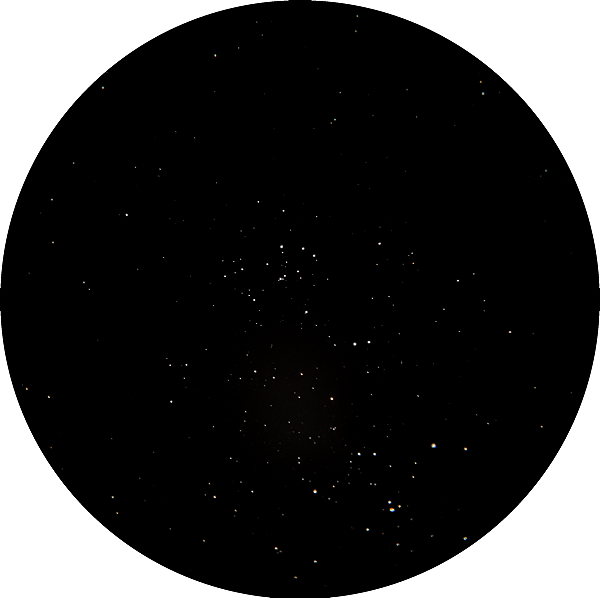iPhone Messier Open Star Clusters,
Sad Night
Posted: 5 September 2022
Thursday, 1 September 2022, was clear until late afternoon when the sky became mostly overcast. With possible thunderstorms in the forecast for the coming days and nights I put the Dome Cover ON. Friday, 2 September, was mostly clear during the daytime, but clouded up as sunset approached. Friday evening I represented Explore Scientific at the general meeting of the Tucson Amateur Astronomy Association to speak about the "David H. Levy Arizona Dark Sky Star Party & The Oracle Dark Sky Cultural Festival" to be held in Oracle, Arizona, 21-25 September, and to introduce David Levy to the audience. Click one of the images below to watch the meeting. I came on at 1:20:54, followed by David.


Click an image to watch the meeting replay
Saturday, 3 September, was overcast and windy. Sunday, 4 September, was mostly clear but windy during the daytime. I was glad it was clear. It would give me some much needed time under the stars due to the death the night before of a good friend of 36 years.
|
Open: Sunday, 4 September 2022, 1805 MST Temperature: 81°F |
Session: 1786 Conditions: Clear, breezy |
Equipment:
12" f/8 LX600 w/StarLock
2" 24mm UWA eyepiece
2" 30mm eyepiece
Camera:
iPhone 13 Pro Max
1817 MST: LX600 ON, StarLock OFF, High Precision OFF.
Viewed the Moon, 102X and 81X.
I mounted the iPhone 13 Pro Max on the 2" 30mm eyepiece using the Phone Skope adapter. Took this afocal photo of the waxing gibbous Moon in the bright blue sky using NightCap Camera (ISO 34, 1/2800sec, 1X lens).

1827-1919 MST: Relaxed on the observatory patio bench.
1835 MST: iPhone photo of the Moon and observatory.

1846 MST: Sunset.
Viewed the Moon, 81X.
1924 MST: Mounted the iPhone on the 30mm eyepiece and took this afocal 81X image using NightCap Camera (ISO 34, 1/2200sec, 1X lens).

1929 MST: iPhone 13 Pro Max handheld photo of the Moon projected onto the observatory dome. Taken with the Camera app (Night Mode, 3 seconds, 1X lens).

1933 MST: High Precision ON.
Viewed M6 (open cluster), 81X. Even though the sky was bright from the nearby gibbous Moon, I decided to image several Messier Catalog open star clusters using the iPhone and NightCap Camera (Long Exposure, various ISO settings, 1sec shutter speed, 1 minute exposures, 1X lens), StarLock autoguided.
1937 MST: StarLock ON.
M6 (ISO 3200)

M7 (ISO 3200)

M18 (ISO 6400)

M21 (ISO 6400)

M23 (ISO 6400)

M25 (ISO 6400)

While using High Precision to slew to several of the open clusters I noticed a faint fuzzy object near the target star SAO 209318. It was NGC6441 (globular cluster, Mag. +7.15). I decided to image it. iPhone, afocal 81X, NightCap Camera (Long Exposure, ISO 3200, 1sec shutter speed, 1 minute exposure, 1X lens), StarLock autoguided. The globular cluster is the fuzzy object at 4 o'clock from the bright star.

2017 MST: StarLock OFF, High Precision OFF.
Viewed NGC6441 (globular cluster), 102X.
I then relaxed on the bench again to look up at the stars and remember my friend and all the exciting and fun times we had. For so many people she was bright star that has gone supernova. Rest in Peace.
Took a quick look at Saturn, 102X.
2030 MST: LX600 OFF.
|
Close: Sunday, 4 September 2022, 2042 MST Temperature: 77°F |
Session Length: 2h 37m Conditions: Clear, breezy |
Friday, 2 September, NOIRLab posted an update on the Kitt Peak National Observatory Contreras Fire recovery efforts.
Comments are welcome using Email. Twitter users can use the button below to tweet this report to their followers. Thanks.
Cassiopeia Observatory Home Page
Copyright ©2022 Michael L. Weasner / mweasner@mac.com. Email Etiquette.
URL = http://www.weasner.com/co/Reports/2022/09/05/index.html
